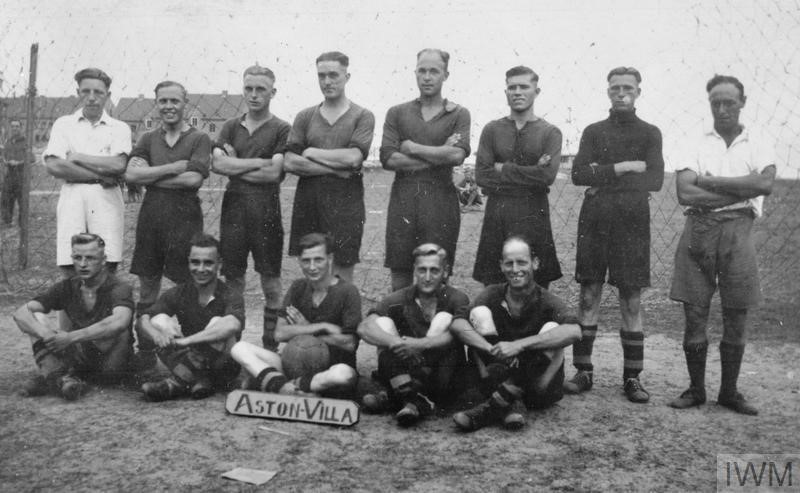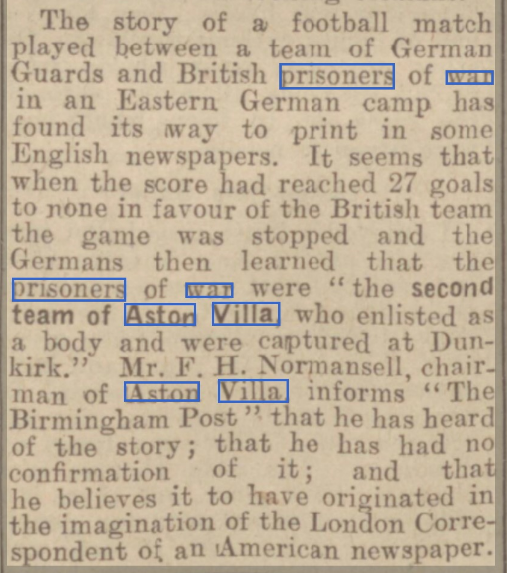The Match That (Probably) Never Was...
26/04/2022 - 2.03
Roger Slater
I finished a couple of projects towards the end of last year, and had a bit of time on my hands, so I delved into the internet to see what I could find relative to Prisoners of War and Football. That story is told in another article, but this story I came across earlier this year.
Perhaps I should start ‘Once upon a time….’ but that would not be strictly indicative or accurate, either to what I’ve found out so far, or indeed to what history may as yet lay uncovered in an article or tucked away in a box that in the future may prove or disprove what follows.
So, early this year I was meandering around the internet looking for links and stories, and I had twitter open on a second screen. A tweet popped up that caught my eye. Originally posted a couple of years ago (I missed it then) but retweeted, it was sent by an Aston Villa fan, Callum Bardsley. He said “I came across this picture today. British soldiers from Birmingham in a PoW Camp, about to play the German Guards. Love the @AVOfficial sign they created for it”. The tweet was accompanied by the picture below, taken from the Imperial War Museum website.

British POWs Aston Villa Football Team. Source: © IWM HU 9282
Where would I go next, but to the Imperial War Museum (IWM) website to see a better image, but also to get some context.
The description says: ‘A group photograph of the "Aston Villa" football team, made of British POWs, at the Stalag XXID, Poznań (Posen). The name of the team would imply those soldiers came from the Birmingham area’. It also mentions that the photograph was originally supplied by the Official German Photographer.
I knew little about PoW football at that time, but I did know that a number of professional footballers had joined up in World War II and I became intrigued to know if any, in particular from Aston Villa, had become POWs and could possibly have been in the photograph. I also wanted to know the result of the match!
The match - or at least a little information about a match between an Aston Villa team and German Guards – was soon found in a search online.
The early Aston Villa History 1874-1961 (maintained by the club) on the Wikipedia website - https://en.wikipedia.org/wiki/History_of_Aston_Villa_F.C._(1874%E2%80%931961) says ‘Their Aston Villa reserves (or seconds) team enlisted in the army and were captured at the Dunkirk evacuation in June 1940. In December in an Eastern German camp, a German Guard regiment challenged British prisoners of war to a game of football; the guards were being defeated 27–0 when they stopped the game, only then learning these prisoners were Aston Villa's second team.
The link reference states that this was published in The Times on Tuesday 31st December 1940, so I looked. It wasn’t. After searching The Times archive, I went back to the Wiki link – clicking the [18] reference link took me to the bottom of the page where the detail for the link was slightly different. That read ’18. Associated Press, "The city's ordeal by fire" (page 5), The Times, 31 December 1940. Retrieved 3 May 2015 but it didn’t link to The Times archive.
What could I do, but click the headline hyperlink which indeed took me, not to The Times but to another website, Airminded, a site mainly dedicated to Air Power between 1908 and 1941 (http://airminded.org/2010/12/31/tuesday-31-december-1940/). There, I was greeted with a story and press cuttings from the Times and the Manchester edition of The Guardian and there was the story, though reading the text, it hadn’t come from The Times, it had in fact been printed by The Guardian. One Free Trial subscription later and I’d copied the following:

Source: British Newspaper Archive
That’s the story. Basically, the Aston Villa Reserve Team had joined up pretty much en-bloc, had served together and a group were among the 80,000 Allied Servicemen captured at Dunkirk. Not only that, but they had remained together – at least, we should assume more than a handful of them – and were ensconced in a PoW Camp in the east of Germany, where the guards had challenged them to a game of football and taken a veritable stuffing before calling a halt to the game.
Nothing else.
Anywhere.
How come? Surely, I’d have heard of this story before and it must have been widely reported – even mentioned again on anniversaries and such like, but nothing. Nada.
I dug a little deeper. Two directions initially – an almost forensic search of the British Newspaper Archive (BNA) online for any other mentions of the match, and also through the Birmingham Post and other West Midlands newspapers to find details of pre-war Aston Villa Reserve players, as in common with most clubs, if they’re not first team they go pretty much unrecorded.
The search on the match drew another blank. Searching from Christmas into January and February there was no mention in the millions of pages and thousands of newspapers that are online at the BNA, so I thought I’d ask an Italian friend of mine (Matteo Tonna) who collects English Football Club histories – he checked through a couple on Aston Villa, and once again, nothing.
Through another friend, Nathan Whitehouse at Chelsea Graves Society, I was then put in touch with another Villa Historian, ‘Ron’ who runs the Aston Villa Graves account. He’d heard the story but only really knew of the report in the newspaper. Like other Villa historians he knew nothing else… He will when he sees this, as I’ll send him the link and my thanks!
One option left, I had to research names. The intention was to build a list of pre-war fringe and Reserve players. I found about thirty names from 1937-1940 from various sources – even a Reserve Match report from a Stoke newspaper in 1938-9. Those on my list had no more than a handful of first team appearances and many had only played in the reserves. Each was then searched with some quite limited parameters as a Prisoner of War. Basically, they had to have a ‘Missing’ or ‘PoW’ record from the second half of 1940, post Dunkirk. With a bit of juggling of details and filters on Forces War Records, Ancestry.co.uk and a few other sites, the list of possible reduced substantially. (I’m pleased to say of the possibles I identified, most survived the war).
The important ones to me, were those that might have been at Dunkirk and might have been prisoners together. Then I looked again at the photograph. Was this even the team I was researching? As it turned out, possibly or indeed probably not as there was every chance that it was a ‘Hut Team’ – a group of prisoners encamped together setting up a barracks team to play matches against fellow prisoners as was common in most allied PoW camps throughout WW2. The IWM though, indicated it was taken at Stalag XXID between 1940 and 1945, so it could have been the right team.
I took a step back. What did I have? A list of Villa players’ names of which no more than three or four could I identify as even possible PoWs, although it did show two at the same camp at the same time. Two professionals surely weren’t going to batter a German opponent 27-0, were they? I had the match report, (in truth, a report of a match with no detail) and I had the picture.
Surely for propaganda reasons and to cheer up everyone at home, the press would have made more of this apparently amazing event?
Back to the BNA, and I started trawling West Midlands Newspapers again – they were great with lists of PoWs from the local area and such like but, until around the middle of January 1941, there was nothing on the match. Then, searching the Birmingham Post, at the bottom of an inside page was a single column piece:
‘The story of a football match between German Guards and British PoWs in an Eastern German PoW Camp has found its way into print in some English Newspapers. It seems that when the score reached 27 – 0 in favour of the British team, the game was stopped, the Germans then learning that the prisoners were the second team of Aston Villa who enlisted as a body and had been captured at Dunkirk’.

Source: British Newspaper Archive
That bit I knew!
The article continued: ‘Mr F H Normansell, Chairman of Aston Villa informs The Birmingham Post that he has heard of the story, that he has had no confirmation of it, and that he believes it to have originated in the imagination of the London Correspondent of an American Newspaper’.
A match that (probably) never happened then, but not quite the end of the story. Not quite…. That picture. It was taken at Stalag XXID Pozen (Poznan) and I had two potential Villa players who had been captured and spent time at Stalag XXI, though B rather than D. bearing in mind these were originally hand written records from verbal notes, maybe a transcription error – it certainly wouldn’t be the first incorrect initial or name I’d come across.
I had two POWs names with correct initials. Researching military records against that information, and I soon had not just initials, but matching Christian names. Villa had a reserve centre half named James Allen. I had a prisoner named James Allen. Villa had a player called George Hardy and I had a prisoner called George Hardy. Both had served in the Pioneer Corps and had been captured near Dunkirk around the end of May 1940. They were both eventually repatriated from Stalag XXIB Szubin on 12th Feb 1945…. Szubin? It’s in Poland now. In the 1940s it was in Eastern Germany as was Stalag XXID Poznan, where the photo ‘may’ have been taken.
Throughout the war the two camps were linked by Military Administrative District XXI, with its capital and administration from Poznan. Where the photograph would have been recorded and sent from…
It does leave me wondering if between 1940 and today someone, somewhere found the picture and the original report, then saw the names that match two of the pre-war Villa squad on the Stalag XXID PoW list and put 2 and 2 together to make 12….or maybe 27.
Biography
Roger Slater was born in Harrow in the late 1950s and has moved around a bit and retired to Devon with wife of 24 years, Helen. He originally trained as an Electrical Engineer but worked for almost 40 years in Building Services Technologies, primarily HVAC control systems and Electronic Security. Roger retired in 2018 having run his own Engineering Consultancy for almost 15 years.
For relaxation and hobbies, he writes, mainly about his football club, Wealdstone FC and has published eight books including a club history since 2002. He does not class himself as a historian, just an enthusiastic amateur.
He also writes for a fanzine/magazine called Where’s The Bar that has just relaunched.
Otherwise, hobbies are upcycling and building ‘strange’ lighting out of people’s rubbish and occasionally painting, though he also buys and sells at auctions and on the internet (mainly football related or antiques).
In respect of other sports, he will watch most but follows the Toronto Blue Jays avidly in baseball, as a result of working on and off in Canada in the early nineties.
Roger also reads and collects books on World War One, in particular personal biographies and war diaries as opposed to battle histories…
All of that could change tomorrow or on any other day if something else takes his fancy as he will give most things a try if they appeal!



/prod01/wlvacuk/media/departments/digital-content-and-communications/images-2024/240624-Alumni-Awards-2024-Resized.jpg)
/prod01/wlvacuk/media/departments/digital-content-and-communications/images-18-19/220325-Engineers_teach_thumbail.jpg)
/prod01/wlvacuk/media/departments/digital-content-and-communications/images-2024/240627-UN-Speaker-Resized.jpg)
/prod01/wlvacuk/media/departments/digital-content-and-communications/images-2024/240320-Uzbekistan-Resized.jpg)
/prod01/wlvacuk/media/departments/digital-content-and-communications/images-2024/240229-The-Link-Resized.jpg)
/prod01/wlvacuk/media/departments/digital-content-and-communications/images-2024/240627-Lady-Aruna-Building-Naming-Resized.jpg)